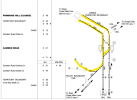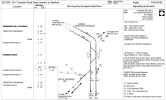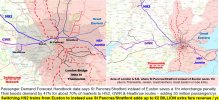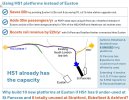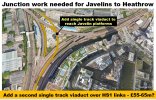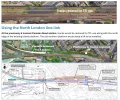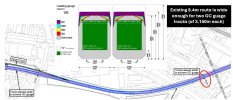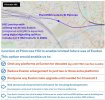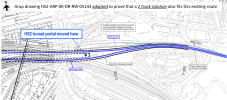Got a bit more time to go back to some other points.
There will be land take. All the reports done on this - at very high level - say there will be; this includes the Arup report you are relying on. Read pages 50 to 77 (Section 7). It mentions demolition of residential, commercial and industrial premises, even for the simplest option (which is less work than what you propose.) The segregated solution, which is similar (but still rather less) to what you propose, involves land take of parts of the various Camden Markets. Good luck with that! That’s just the permanent land take; during construction there will be much more, including the severance of roads throughout the area. This is not me saying this, it is the Arup report.
As explained above - they can’t all be timetabled that way, because additional freight that joins the NLL from the Gospel Oak - Barking line fits into the spaces vacated by the trains pathed via Primrose Hill. There is not room to expand freight 8 fold. Not even 1/8th fold. I have seen recent work that demonstrates the capacity issues on the NLL - it is quite possible that Network Rail starts taking trains out of the existing timetable as it simply doesn’t work now. There is certainly not scope for diverting all the Primrose Hill trains via Gospel Oak on a permanent basis. There must be a freight route via Primrose Hill, as proposed in all the Arup options, so you need to amend your proposal to accommodate it.
Without going down there, taking a line block and getting my tape measure out, I don’t know how to prove it to you. However gauging is about much, much more than static measurement of one point of a viaduct. GC gauge has a much bigger kinematic envelope (KE) than W10, with centre throw and end throw being particular issues on curves, especially tight curves as we have here. The tracks must be further apart throughout, and that causes gauge infringement with the parapet walls of the masonry viaducts. Then there is below the solebar, and all the kit we put there that is in the way of GC. Then of course the height - all that OLE is in the way and will have to go, along with the portals holding it up.
See below, from the Arup report, my bold and reddening.
1) Can you explain how much money the shorter tunnel saves money compared to the tunnel to Euston. Just for the tunnel section, nothing else. In your answer, take into account that the contracts have been let, the materials all procured, the TBMs are bought and being assembelled, the Euston portal well under construction, and all the geotechnical investigations, design, and prep works done and paid for. Also bear in mind that none of this investigation or prep work has been done for a tunnel emerging at Primrose Hill.
2) Can you set out some high level milestones that show how it can be delivered earlier than a rebuilt Euston. Start with the consents process.
3) Yet again, NO NEED TO SHOUT.
Thanks Rick,
Since Arup's 2014 report, buildings alongside have been removed and there are now two wide passageways (Water Lane) that remove need of land take.
I have indeed used my Disto (more accurate than a tape measure) and the viaduct is 8.4 to 8.5 metres wide with 315mm brick non-structural parapets that could be removed.
Signaling is already cantilevered over the side - as could any walkway and/or narrower metal handrail, with easy scaffolding access from Water lane to remove parapets.

I see no demolition necessary apart from the roof and 1st floor of one dentist surgery at Kentish Town road (where the Victorians failed to 4 track the route and a wider viaduct is need to span over (and thus shelter) the rear of the school playground. That single demolition is shown as red dotted lines below. But the same dentists could re-open as a single floor building under the bridge and using the rear garden of the same property to add back the missing 1st floor space. Its already got a similar extension on the front.

2) As mentioned elsewhere by other people, freight trains have no problem running to Willesden. Avoiding the single Gospel Oak train, 6 other paths are available per hour.
3) Contracts are subject to change and those same TBMs would just stop north of Juniper Crescent (by Primrose Hill) instead of digging an extra 1km towards Euston.
The savings are in postponing Euston until a much smaller and more integrated station can be designed where HS2 and normal trains share the same (widened) surface level throat and share some platforms too in a much more flexible way. Most HS2 trains would run to St Pancras (all classic compatibles and when we get use of 2 of the 400m platforms - eg 5 and 10 some of the 400m trains too) with the Birmingham shuttle only starting to use Euston in the late 2030s or 2040s.
The boosted income comes from getting trains into central London earlier than Euston could be opened and in those interchange savings that boost HS2 (and cross London) markets.
What we need to do urgently is work out how to add an S shaped single tracked ramp within the O.O.C. box (very similar to the same ramp to Temple Mills at Stratford) to link Javelin trains to GWR platforms alongside and enable them to extend to replace the 4 paths of the Heathrow Express.
4) No consents (Limit of Deviation or Parliamentary) are needed as this is all within Railway Land. Its a railway upgrade where only Camden Council need to approve replacement work of the steelwork over the existing railway bridges to replace Victorian I beams with side-arched bridges that could be slightly wider. The iconic "Camden Road" side panel could possibly be added back (somehow?) or an open arch could replace it. Other minor bridges east of Camden Road could be simpler and cheaper concrete planks.
The key things though are that as TfL saves £1billion by not needing to upgrade Euston tube (and also saves money on yet more Elizabeth Line trains) they can afford about £50m to £60m to 4 track the route (re-decking bridges, adding track, restoring the old platforms and adding a lift and widening Kentish Town Road bridge).
HS1 Ltd get a huge boost to the value of their stations and HS1 itself, so they can afford to (a) add your junction links & signaling at St Pancras junction (b) widen the 1 track viaduct to 2 track and (c) add a reversable single track viaduct curving over the middle of the triangle to descend in the gap between tracks (or over the boat dock) to reach Javelin platforms. Engineers tell me having a concrete works on site in that triangle could actually reduce costs

They could also afford to add extra lifts by the Javelin platforms and fill in the draft atrium to add more seating space there. There is even height space there to add a balcony.
And of course it would be sensible to raise the floor level of the old platform alongside platform 10 to allow the flexibility of using it for rush hour Javelins.
So this doesn't just save HS2 costs. It provides much
earlier income and
boosted income too (by removing the interchange penalty).
It adds HS1 & Tfl to pay costs, whilst also enabling more lucrative use of most of the cleared land at Euston (as fewer platforms would ever be needed there).
You made a good point about 7 Javelins per hour at rush hour. Looking further at that
a) Two of them are to Ashford. By simply extending 3 of the HS2 trains in rush hour from terminating in a double slot at St Pancras to terminating at Ashford,
(i) we remove the need of 2 of those 7 Javelins and (ii) we create 3 extra slots of 7.5 minutes in rush hour to use for a 5th Javelin service to say Margate.
b) Another option would be to use 30 6 minute slots /hr instead of 24 7.5 minute slots as that adds room for your 3 extra Javelins (in those 6 extra slots).
c) My favoured option is to persuade HS1 Ltd to release platform 10 for say 90 minutes around rush hours to add 12 extra slots for each rush hour.
In reality, extra HS2 trains would certainly extend to Ashford in rush hour to return in less crowded hours afterwards and we could see a combination of these solutions.
Happy to
underline or use bold instead of CAPITALS now I see the options. Apologies as I'm new to this site



That bridge is IMPOSSIBLE. Stop repeating it as an option.
There is no physical way in that distance to get a line up and over and down into St Pancras using the basic limitations of gravity.
I think you are being incredibly rude in your postings on here and you have not responded to any valid critiscism.
You can claim that only 4 javelins per hour use St Pancras normally, however at some point you will have to face that in reality at rush hour it is much more and this is likely when you will have your HS2 services arriving.
I am sure all the HS1 javelin customers will also be thrilled that they are now getting dumped in OOC rather than St Pancras.
That bridge isn't impossible as I have measured the gradients. Although it might need to span to the side dock I accept.
I'm new to this site and have been away (on train trips to York and Harrogate) with only access to a phone rather than this laptop. I'd not seen the questions as I had not seen the tiny page numbers on my phone. I'm only now getting time to respond. Please bear with me. I'm grateful for your comments and questions.
I really have answered the 7 Javelins per hour question - saying that (a) HS2 trains extending at rush hour to Ashford replace need of 2 of the 7, (b) 6 minute slots add room for 3 extra Javelins or (c) use of platform 10 at rush hours would add an extra 12 slots or 7.5 minutes to reverse Javelins towards OOC.
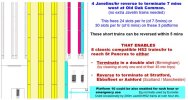
All Javelin passengers could get on and off at St Pancras. But many passengers would stay on board to reach OOC (or ideally Heathrow if a Stratford international style ramp was added within the bare box so far completed at OOC - S curving over the platforms. Again its a 500m ramp at the gradient able to be used by those trains. I have checked that.
Almost all trains would use St Pancras so Nobody is being "dumped" at OOC.
4 Javelins and 8 HS2 trains per hour would stop at each of Stratford, St Pancras and Old Oak Common. Some empty to depot trains from OOC might bypass St Pancras.
The 12 trains/hr reversing in around 4 to 5 minutes at St Pancras would create a new ACROSSRAIL service.
ICE trains reverse in the same timeframe at Frankfurt HbH.
Option 1
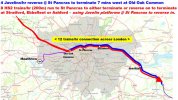 Option 2
Option 2
 Option 3
Option 3


